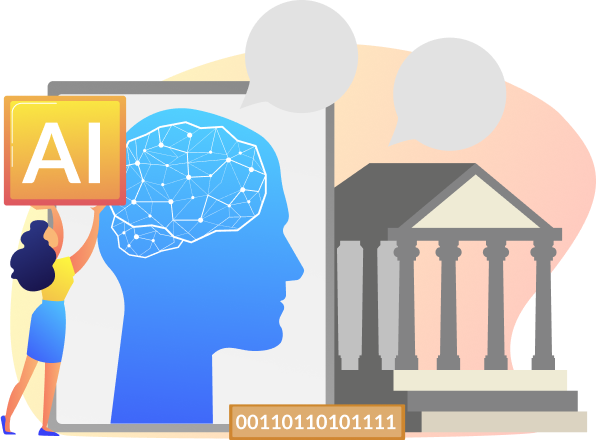 Blog posts
Blog posts
Can AI-based messaging improve financial services communication?
 Newristics
Newristics
 18 July 2022
18 July 2022
Optimize Pharma GTM communications
Innovative messaging market research
Analyze messaging with algorithms
Source for pharma insights and updates
Pharma's top behavioral science source
 Back
Back
Can AI-based messaging improve financial services communication?
 Newristics
Newristics
 18 July 2022
18 July 2022

Acquiring new customers has always been difficult for financial institutions, but it’s becoming increasingly more challenging and expensive now. In the face of an evolving digital environment, increasing competition, and rapidly changing customer preferences, acquisition has never been more difficult in the financial services industry. Successful customer acquisition strategies now require multiple touchpoints across marketing channels, and personalized methods of engagement.
What makes customer acquisition so challenging in financial services?
Many financial services are sticky, i.e., once a customer makes a choice, they tend to stick to it for a long time. It’s not every day that we search for a new bank, credit card, or insurance company. In fact, most customers don’t even consider searching the industry unless triggered by a life event or need. Whether opening a first bank account, moving to a new area, or frustrated with a current account, few people actively look for a service unless driven by an important life event.
Customer acquisition is heavily influenced by pain points. Customers will join or switch only when they feel their needs are not being met with their current provider. When driven to make a purchase decision, the search is short–and often driven by emotions. Customers base their decisions on what's in front of them and appeals to them in the moment.
Customer messaging is essential. Customer acquisition cannot be forced, and instead financial institutions must focus on targeting the right audience with the right messaging at the right time.

Messaging must be perfect to acquire more customers. While banks and FinTech are increasingly competing, they also must keep up with other tech giants like Amazon, Apple, and Google to survive. Messaging is an essential vehicle to drive strong, sustainable relationships with customers. These complexities have led to growing messaging demands on financial services:
More campaigns
The digital world has opened new avenues for financial services to communicate with customers. While this provides new opportunities to reach the customer, this qualifies the need for always on, well thought-out messaging that engages your current and prospective customers.
More persuasion
Every day, customers are bombarded with more information than they can possibly retain. To get a message across, financial marketers must cut through information overload and tell a compelling story that appeals directly to the customer.
More channels
The need for omnipresent, omnichannel marketing that reaches the customer on multiple platforms is a new reality. Omnipresence means meeting your customer where they’re at every stage in the customer journey. From first contact to final sale, customers demand seamless and consistent experiences anywhere and anytime.
More personalization
Customers are increasingly demanding personalized experiences tailored to address their specific needs. Financial services can build trust and loyalty by delivering personalized messaging throughout the customer journey.
More human
Humans are relational, and empathy has enabled us to connect, create, survive, and thrive from the beginning of time. However, digital technology and automation have changed the way people interact, making basic human interactions more difficult than ever before. That’s why it’s critical to infuse empathy-based messaging in marketing, satisfying these human needs and understanding who your customers are and what motivates them.
To keep up with these ever-evolving demands, financial service marketers are constantly searching for technological solutions to help them deliver faster, stronger, and more effective messaging strategies.
The solution: ARTIFICIAL INTELLIGENCE

A study by Deloitte found that 30% of financial services firms they describe as AI frontrunners are more adept at utilizing AI in marketing, helping them achieve the highest financial returns from AI implementations.
AI content writing has the power to transform financial services communication. As customers demand instant customized, and connected experiences, companies are forced to stay ahead of customer-centric marketing technologies or risk falling behind. This is especially true for financial services companies that must transition from traditional messaging approaches to carefully crafted customer-focused outreach.
From creating simple digital copy to long-form pieces such as blogs and articles, Message Development AI Platforms may hold the key. Hundreds of SaaS companies are now making massive language models, democratizing Natural Language Generation (NGL) for the whole world and making it easy to generate copious amounts of AI marketing content. It is clear that AI is the future of messaging in financial services, but many organizations are still facing challenges with understanding AI and how to leverage it most effectively.
How do you integrate AI messaging into current marketing platforms? How do you leverage these platforms to create the best content possible? How well do these platforms actually perform? Are these platforms good enough to replace humans? How can you ensure that AI messaging aligns with current brand messages? There are so many platforms out there, so how do you choose the AI content generator that best fits your company’s needs?

Choice Overload: With hundreds of platforms to choose from, narrowing the best-fit option is harrowing. Companies may become overwhelmed with the number of choices and fail to decide at all.

Ambiguity: Artificial Intelligence is complex as is. When diving in deeper, the pros and cons of individual message development AI platforms are often unclear and ambiguous.

Lack of Differentiation: Many of the platforms have the same or similar underlying algorithms so it is very difficult to compare and choose the right one.

Free Trial Temptations: Many platforms offer free trials to get started and while they are nice to have, they do not simplify the decision-making process.

Differing Needs: The perfect platform is hard to find–discovering the right platform that satisfies your specific needs and use cases can be a mind-boggling challenge.
To uncover the ambiguities of Message Development AI Platforms and overcome these decision-making obstacles, Newristics conducted a large-scale study to evaluate the effectiveness of 50 different AI platforms for messaging development.
While all the evaluated Message Development AI platforms were designed to create copy, they varied across a range of parameters including:
After exploring the writing approaches, input requirements, use cases, and price models, these platforms were further evaluated on a variety of strategic criteria.
Overall, thorough investigation and evaluation of the 50 different Message Development AI platforms demonstrated that copywriting AI has several benefits in making copywriting easier and more efficient. However, they are far from perfect—when implementing AI writing for successful marketing efforts, you should be aware of their limitations. Here are the top 8 lessons learned from evaluation of 50 different Message Development AI Platforms.
Human intervention is required: Most of the platforms produce AI content writing that requires significant human supervision.
Few algorithmic differences: Most of the AI content generators use the same 1-2 backend algorithms even though the frontend looks very different.
Quick but irrelevant: Platforms generate AI content writing in seconds, but much of it can be irrelevant.
Inconsistent output: The output of many platforms varies wildly - delightful at some times and embarrassing at others.
Sign up and forget: Most platforms make it very easy for customers to sign up and get started, but continued use is not easy.
Brute force patterns: Many of the platforms use brute force patterns to create content without understanding the context.
Predictive scores missing: Most of the platforms are not able to predictively score the copy options they generate.
Not designed for Good to Great: Few platforms are designed to take already GOOD messaging to GREAT.
Newristics is famous for helping brands optimize messaging using a combination of behavioral science and machine learning algorithms. In the past ten years, Newristics has optimized messaging for 100s of world-leading brands generating $100s billion in revenue every year.